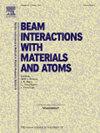使用PIXE对影响墨西哥城大气的野火事件进行空气质量评估
IF 1.4
3区 物理与天体物理
Q3 INSTRUMENTS & INSTRUMENTATION
Nuclear Instruments & Methods in Physics Research Section B-beam Interactions With Materials and Atoms
Pub Date : 2025-05-13
DOI:10.1016/j.nimb.2025.165733
引用次数: 0
摘要
利用粒子诱导x射线发射(PIXE)对2019年5月发生在墨西哥南部和中部的多起生物质燃烧野火进行了调查。该事件严重影响了墨西哥城大都市区(MCMA),导致包括细颗粒物(PM2.5)在内的各种污染物浓度升高,这些污染物在该地区累积了数天。2019年墨西哥实施的PM2.5质量浓度最大值为63µg/m3, 24小时内超过了45µg/m3的墨西哥空气质量标准。在野火发生期间收集PM2.5样本,并通过pxie进行分析以确定其元素浓度。此外,一个并联运行的大容量PM2.5采样器提供了测定有机碳(OC)和元素碳(EC)的样品。生成PM2.5、OC和EC的时间序列,以及分别被认为是生物质燃烧(K)和化石燃料燃烧(S和V)良好标志的元素。结果显示了与其来源相符的趋势,验证了来自共同来源的颗粒的存在,无论是来自生物质燃烧还是来自化石燃料燃烧。这些结果与使用HYSPLIT模型计算简单气团轨迹生成的气溶胶输送轨迹进行了交叉比较,结果一致。在事件最关键时期(2019年5月9日至18日)之前、期间和之后,利用其相应的富集因子对非土壤(烟)钾进行了估算,表明野火确实是事件高峰期附近当地大气污染的主要贡献者。示踪剂时间序列被证明是将污染物与其来源联系起来的一项非常宝贵的资产。本文章由计算机程序翻译,如有差异,请以英文原文为准。
Air quality assessment of a wildfires event affecting Mexico City’s atmosphere using PIXE
An event involving multiple biomass burning wildfires that occurred in southern and central Mexico during May 2019 was investigated using Particle Induced X-ray Emission (PIXE). The event severely affected the Mexico City Metropolitan Area (MCMA), resulting in elevated concentrations of various pollutants, including fine particulate matter (PM2.5), which accumulated in the region over several days. PM2.5 mass concentration reached a maximum value of 63 µg/m3, exceeding the Mexican Air Quality Standard of 45 µg/m3 in 24 h, in effect in Mexico in 2019. PM2.5 samples were collected during the wildfires episode and analyzed by PIXE to determine their elemental concentrations. Additionally, a high-volume PM2.5 sampler operating in parallel provided samples to determine organic carbon (OC) and elemental carbon (EC). Time series of PM2.5, OC, and EC, as well as those elements considered respectively good markers of biomass burning (K) and fossil fuel combustion (S and V) were generated. The results revealed trends in accordance with their origin, verifying the presence of particles proceeding from common sources, either from biomass burning or fossil fuel combustion. These results were cross compared with aerosol transport trajectories generated using the HYSPLIT model for computing simple air parcel trajectories, showing to be in agreement. Non-soil (smoke) potassium was estimated using its corresponding enrichment factor before, during, and after the most critical period of the event (May 9–18, 2019), indicating that wildfires were indeed the main contributors to the local atmospheric pollution around the peak of the event. Tracers time series proved to be a very valuable asset to link the pollutants to their sources.
求助全文
通过发布文献求助,成功后即可免费获取论文全文。
去求助
来源期刊
CiteScore
2.80
自引率
7.70%
发文量
231
审稿时长
1.9 months
期刊介绍:
Section B of Nuclear Instruments and Methods in Physics Research covers all aspects of the interaction of energetic beams with atoms, molecules and aggregate forms of matter. This includes ion beam analysis and ion beam modification of materials as well as basic data of importance for these studies. Topics of general interest include: atomic collisions in solids, particle channelling, all aspects of collision cascades, the modification of materials by energetic beams, ion implantation, irradiation - induced changes in materials, the physics and chemistry of beam interactions and the analysis of materials by all forms of energetic radiation. Modification by ion, laser and electron beams for the study of electronic materials, metals, ceramics, insulators, polymers and other important and new materials systems are included. Related studies, such as the application of ion beam analysis to biological, archaeological and geological samples as well as applications to solve problems in planetary science are also welcome. Energetic beams of interest include atomic and molecular ions, neutrons, positrons and muons, plasmas directed at surfaces, electron and photon beams, including laser treated surfaces and studies of solids by photon radiation from rotating anodes, synchrotrons, etc. In addition, the interaction between various forms of radiation and radiation-induced deposition processes are relevant.

 求助内容:
求助内容: 应助结果提醒方式:
应助结果提醒方式:


